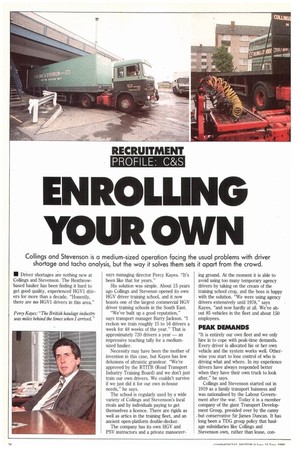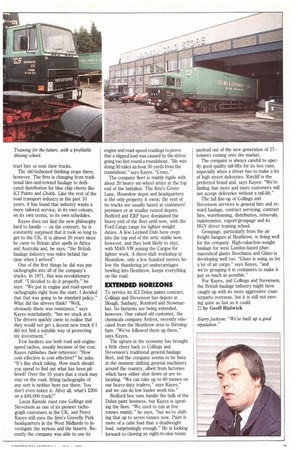ENROLLING YOUR OWN
Page 38

Page 39

If you've noticed an error in this article please click here to report it so we can fix it.
Collings and Stevenson is a medium-sized operation facing the usual problems with driver shortage and tacho analysis, but the way it solves them sets it apart from the crowd.
• Driver shortages are nothing new at Collings and,Stevenson. The Heathrowbased haulier has been finding it hard to get good quality, experienced HGV1 drivers for more than a decade. "Honestly, there are no HGV1 drivers in this area,"
says managing director Percy Kayes. "It's been like that for years."
His solution was simple. About 15 years ago Collings and Stevensn opened its own HGV driver training school, and it now boasts one of the largest commercial HGV driver training schools in the South East.
"We've built up a good reputation," says transport manager Barry Jackson. "I reckon we train roughly 15 to 16 drivers a week for 48 weeks of the year." That is approximately 720 drivers a year — an impressive teaching tally for a mediumsized haulier.
Necessity may have been the mother of invention in this case, but Kayes has few delusions of altruistic grandeur. "We're approved by the RTITB (Road Transport industry Training Board) and we don't just train our own drivers. We couldn't survive if we just did it for our own in-house needs," he says.
The school is regularly used by a wide variety of Collings and Stevenson's local rivals and by individuals paying to get themselves a licence. There are rigids as well as artics in the training fleet, and an ancient open-platform double-decker.
The company has its own HGV and PSV instructors and a private manoeuvr ing ground. At the moment it is able to avoid using too many temporary agency drivers by taking on the cream of the training school crop, and the boss is happy with the solution. "We were using agency drivers extensively until 1978," says }Cayes, "and now hardly at all. We've about 85 vehicles in the fleet and about 150 employees.
PEAK DEMANDS
"It is entirely our own fleet and we only hire in to cope with peak-time demands. Every driver is allocated his or her own vehicle and the system works well. Otherwise you start to lose control of who is driving what and where. In my experience drivers have always responded better when they have their own truck to look after," he says.
Collings and Stevenson started out in 1919 as a family transport buisness and was nationalised by the Labour Government after the war. Today it is a member company of the giant Transport Development Group, presided over by the canny but conservative Sir James Duncan. It has long been a TDG group policy that haulage subsidiaries like Collings and Stevenson own, rather than lease, con tract hire or rent their trucks.
The old-fashioned thinking stops there, however. The firm is changing from traditional hire-and-reward haulage to dedicated distribution for blue chip clients like ICI Paints and Chubb. Like the rest of the road transport industry in the past 10 years, it has found that industry wants a more tailored service, in its own colours, on its own terms, to its own schedules.
Kayes does not find the new philosophy hard to handle — on the contrary, he is constantly surprised that it took so long to get to the UK. It is almost 20 years since he came to Britain after spells in Africa and Australia and, he says, "the British haulage industry was miles behind the time when I arrived".
One of the first things he did was put tachographs into all of the company's trucks. In 1971, this was revolutionary stuff. "I decided to do it properly," he says. "We put in engine and road-speed tachographs right from the start. I decided that that was going to be standard policy." What did the drivers think? "Well, obviously there was resistance," says Kayes nonchalantly, "but we stuck at it. The drivers quickly came to realise that they would not get a decent new truck if I did not find a suitable way of protecting my investment."
Few hauliers use both road and enginespeed tachos, usually because of the cost. Kayes rubbishes their reticence: "How cost effective is cost effective?" he asks. "It's like stock taking. How much should you spend to find out what has been pilfered? Over the 10 years that a truck may stay on the road, fitting tachographs of any sort is neither here nor there. You don't even notice it. After all, what's .E200 on a £40,000 truck?"
Lucas Kienzle must rate Collings and Stevenson as one of its pioneer tachograph customers in the UK, and Percy Kayes still uses the firm's Gravelly Park headquarters in the West Midlands to investigate the serious and the bizarre. Recently the company was able to use its engine and road-speed readings to prove that a slipped load was caused by the driver going too fast round a roundabout. "He was doing 30 miles an hour 30 yards from the roundabout," says Kayes. "Crazy."
The company fleet is mainly rigids with about 20 heavy six-wheel artics at the top end of the battalion. The firm's Green Lane, Hounslow depot and headquarters is the only property it owns; the rest of its trucks are usually based at customers' premises or at smaller rented depots. Bedford and ERF have dominated the heavy end of the fleet until now, with the Ford Cargo range for lighter-weight duties. A few Leyland Dafs have crept into the top end of the artic stable now, however, and they look likely to stay, with MAN-VW joining the Cargos for lighter work. A three-shift workshop at Hounslow, only a few hundred metres below the thundering jet undercarriages howling into Heathrow, keeps everything on the road.
EXTENDED HORIZONS
To service its ICI Dulux paints contract, Collings and Stevenson has depots at Slough, Sunbury, Romford and Stowmarket. Its horizons are being extended, however. One valued old customer, the chemicals company Ardrox, recently relocated from the Heathrow area to Birmingham. "We've followed them up there," says Kayes.
The upturn in the economy has brought a little cheer back to Collings and Stevenson's traditional general haulage fleet, and the company seems to be busy at the moment shifting general machinery around the country, albeit from factories which have either shut down or are relocating. "We can take up to 60 tonnes on our heavy-duty trailers," says Kayes," and we can do low loader work too."
Bedford box vans handle the bulk of the Dulux paint business, but Kayes is uprating the fleet. "We used to run at five tonnes mainly," he says, "but we're shifting that up to seven tonnes now. Paint is more of a cube load than a deadweight load, surprisningly enough." He is looking forward to clawing an eight-to-nine-tonne payload out of the new generation of 17tonners coming onto the market.
The company is always careful to specify good quality tail-lifts for its box vans, especially when a driver has to make a lot of high street deliveries. Ratcliff is the preferred brand and, says Kayes: "We're finding that more and more customers will not accept deliveries without a tail-lift."
The full line-up of Collings and Stevenson services is general hire and reward haulage, contract servicing, contract hire, warehousing, distribution, removals, maintenance, exportigroupage and its HGV driver training school.
Groupage, particularly from the air freight hangars at Heathrow, is doing well for the company. High-value/low-weight haulage for west London-based pharmaceutical giants Beechams and Glaxo is developing well too: "Glaxo is using us for a lot of air cargo," says Kayes, "and we're grouping it in containers to make it pay as much as possible."
For Kayes, and Collings and Stevenson, the British haulage industry might have caught up with its more aggressive counterparts overseas, but it is still not moving quite as fast as it could.
El by Geoff Hadwick
















































































































